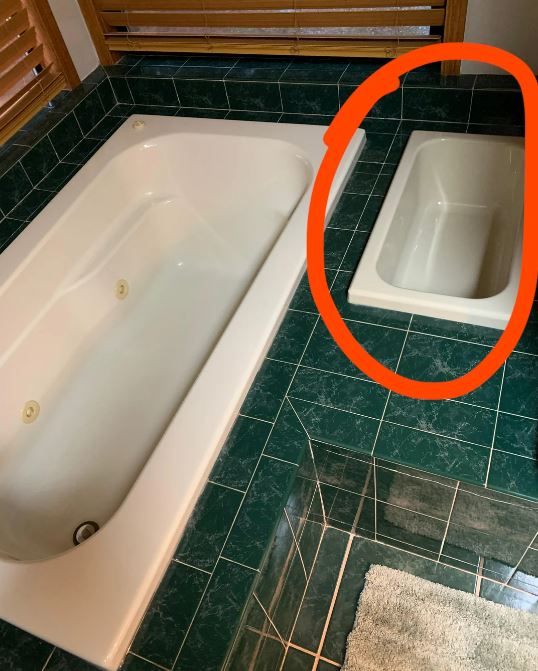ADVERTISEMENT
Discover the Jaw-Dropping Bathroom Trend Sweeping Homes – Small Tubs Next to Big Tubs!
When it comes to bathroom design, we often see the same recurring elements: sleek showers, oversized bathtubs, and a minimalist aesthetic. However, a new trend has emerged that’s capturing the attention of homeowners and interior designers alike—a quirky, yet practical, twist on traditional bathtub setups: small tubs next to big tubs. This unexpected trend is taking the bathroom world by storm, and it’s not just about aesthetics; it offers a unique blend of functionality and visual appeal.
So why is this trend gaining so much attention, and how can you incorporate it into your own home? Let’s dive into the details of this jaw-dropping bathroom trend that’s sweeping homes across the globe.
Why Small Tubs Next to Big Tubs?
At first glance, the idea of placing a small tub next to a larger one may seem unconventional. However, there’s more to this trend than meets the eye. Here’s why this design concept is becoming increasingly popular:
1. Versatility and Functionality
Having both a small tub and a larger tub in the same space offers versatile bathing options. The larger tub—often a freestanding or soaking tub—provides ample space for a luxurious, relaxing bath. Meanwhile, the smaller tub, which could be a deep soaking tub, Japanese-style tub, or even a child-sized tub, can serve different purposes:
- Relaxation for Different Needs: Whether you’re looking for a quick soak or a long, luxurious bath, the two tubs offer flexibility. The smaller tub might be ideal for a quick wash or a more focused, therapeutic soak, while the larger tub provides a spacious area for a full, indulgent bath experience.
- Family-Friendly Design: Families with young children often appreciate the addition of a small tub. It allows parents to comfortably bathe their kids while still offering a space for their own relaxation in the larger tub.
2. Enhanced Aesthetic Appeal
The juxtaposition of the small and large tubs creates a striking visual effect in the bathroom. It’s a design choice that challenges conventional bathroom layouts, drawing the eye and adding a touch of intrigue. The contrast in size and shape between the two tubs makes a bold statement, yet the arrangement can feel harmoniously balanced when executed well.
- Architectural Statement: The small tub next to a larger one can become a focal point of the bathroom, transforming it from a functional space into a design statement. Depending on the material, shape, and style of the tubs, this arrangement can evoke a variety of moods, from serene and spa-like to modern and edgy.
- Customization: This trend also allows for a high level of customization. You can mix and match tub styles to suit your personal taste. Whether you prefer a minimalist modern look with sleek tubs or a more rustic charm with freestanding copper tubs, the small and big tub combo can be tailored to any design vision.
3. Increased Luxury and Relaxation
A bathroom is a personal sanctuary where we seek relaxation and rejuvenation. Having two tubs allows homeowners to create a more personalized and luxurious bathing experience. Imagine a scenario where you’re in the larger tub, enjoying a bubble bath or using a bath bomb, while the smaller tub serves as a more intimate space for a deep soak with essential oils or a favorite bath salt. The possibilities for indulgence are endless!
How to Incorporate Small Tubs Next to Big Tubs in Your Bathroom
If you’re thinking of embracing this bold bathroom trend, here are some tips on how to create a stunning and functional space with small tubs next to big tubs:
1. Space Planning
This trend works best in larger bathrooms with ample space to accommodate both tubs. It’s essential to consider the layout of your bathroom before jumping into this trend. Ensure there’s enough room between the two tubs for movement and functionality. A corner placement or an arrangement that uses the space along one wall might be ideal, as it allows both tubs to be easily accessible without overcrowding the area.
2. Harmonize the Tubs’ Style
While the two tubs will vary in size, their style should complement each other. If you’re going for a modern look, consider choosing tubs with similar sleek finishes, such as matte black or white ceramic. For a more traditional vibe, you could go with a clawfoot tub paired with a smaller, freestanding tub with vintage-inspired design details. Regardless of the style you choose, aim to maintain a cohesive look that ties the two tubs together.
For Complete Cooking STEPS Please Head On Over To Next Page Or Open button (>) and don’t forget to SHARE with your Facebook friends
